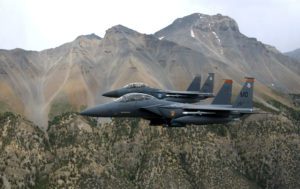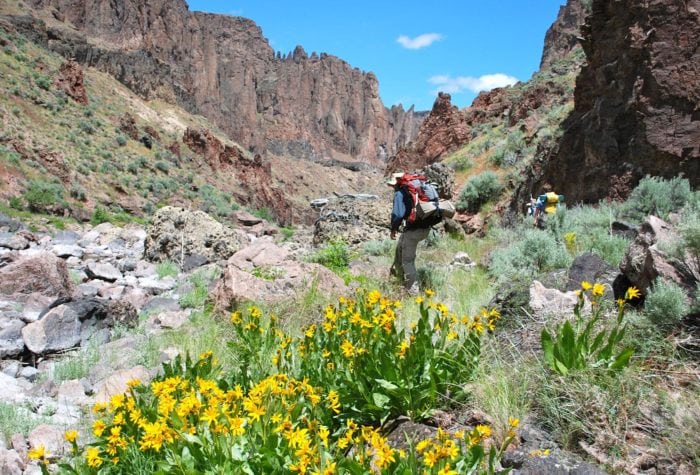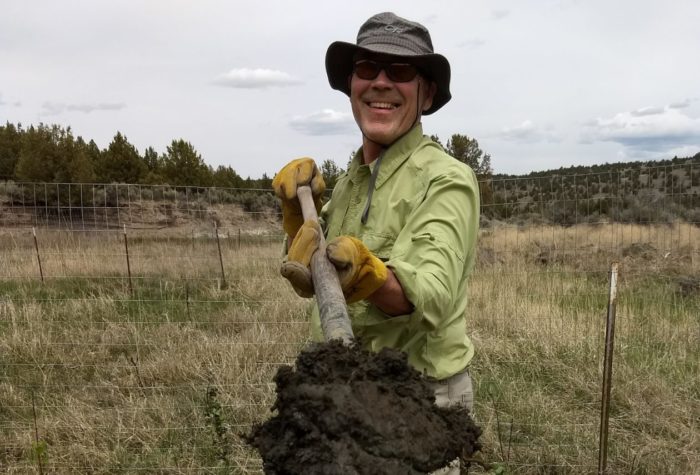The time period to comment on this item has now closed. Please subscribe to ONDA’s newsletter to learn about upcoming opportunities.
Military training threatens remarkable wildlife, wildlands and waterways across Oregon’s Owyhee Canyonlands.

The U.S. Air Force has released a proposal to expand military aircraft training across huge swaths of southeastern Oregon, northern Nevada, and southwestern Idaho. The proposal threatens to subvert broadly supported efforts to conserve one of the wildest expanses of Oregon’s high desert and would impact the region’s nationally-renowned wildlife, wilderness and waters.
The Air Force’s controversial plan:
- Fails to properly analyze and mitigate for the impacts of jetfighter noise on the region’s wilderness, recreation and wildlife values
- Disregards decades-long efforts to conserve sagebrush landscapes, waters and wildlife—including the greater sage-grouse
- Fails to protect wilderness quality lands from intrusive training exercises
- Exposes wild desert places to increased risk of fire
Thanks to a push from Oregon’s Senators Ron Wyden and Jeff Merkley, the Air Force has extended their comment deadline through October 25, 2021 on the Proposal for Airspace Optimization for Readiness at Mountain Home Air Force Base Draft Environmental Impact Statement.
The Air Force needs to hear that there is strong, broad support for conservation in the Owyhee Canyonlands and southeastern Oregon, and that their proposal threatens to undermine the qualities that make this region so exceptional.
As someone who knows and loves these public lands, your voice is key.
You can copy and paste the comment text below and submit it to the U.S. Air Force. Modify or personalize as you wish.
Thank you for accepting my comments on the Airspace Optimization for Readiness at Mountain Home Air Force Base Draft Environmental Impact Statement (DEIS).
-
- I’m opposed to the Air Force’s proposal to expand low elevation and supersonic training airspace across southeastern Oregon as it would increase wildfire risk, negatively impact sensitive wildlife, ruin the area’s renowned opportunities for solitude and quiet backcountry recreation, and undermine years of work by stakeholders from across the West to protect one of the most spectacular areas in Oregon’s high desert: the Owyhee Canyonlands. Oregon’s senators have proposed protecting more than 1 million acres of wilderness in the Owyhee Canyonlands, and designating 33 miles of Wild and Scenic Rivers in Oregon where the military has proposed more, and more intensive training.
-
- One of the most important core populations of greater sage-grouse in the West is located squarely in the Mountain Home Airspace project area. Sage-grouse populations have been declining for decades, and have suffered even steeper declines in recent years. Frequent overflights and sonic booms will only further threaten the species by increasing stress levels and impeding communication and participation in mating behavior. The science is clear that sage-grouse and many other wildlife species are sensitive to human-generated noise on the landscape. The Air Force must consider the best available science and abide important restrictions in underlying land use plans—including those related to noise and anthropogenic disturbance in state and federal sage-grouse plans.
-
- The Owyhee Canyonlands, known locally as the “Big Quiet,” is one of the most remote locations in the Lower 48, with few roads, little cell phone coverage and some of the country’s darkest night skies. The remote nature of this landscape draws visitors from all walks of life to enjoy unparalleled solitude, while fishing, hunting, backpacking, camping, stargazing and more. Allowing military fighter jets to train and fly as low as 100 feet above the ground and at supersonic speeds would spoil the quiet solitude and backcountry experience offered in the Owyhee Canyonlands. The U.S. Air Force must keep to current altitudinal flight restrictions and choose more appropriate non-wilderness quality areas for military training.
-
- In Oregon alone, the DEIS’ proposed changes would increase the frequency that aircraft can break the sound barrier to nearly 19 times per day. These supersonic flights will result in a series of “sonic booms,” which have been documented to damage hearing, damage property and even cause death. The negative health effects to both people and wildlife from frequent supersonic flights are unacceptable and as such, this kind of training should not be permitted in the Owyhee Canyonlands and southeastern Oregon.
-
- At a time when the state is already facing unprecedented drought conditions and wildfire activity, this proposal would escalate wildfire risk in southeastern Oregon. There is a long history of military training activities that use flares and chaff bundles igniting fires in eastern Oregon, including in 2017 when a series of seven fires burned through important sage-grouse habitat and public and private lands. This proposal only exacerbates that danger, as thousands of flares and chaff bundles would be used annually across the area, littering and polluting the landscape while increasing the risk of large wildfires.
Thank you for your consideration of these comments, and ensuring that your plan provides for Oregon’s high desert wildlife, wildlands, wild waters and local communities.

